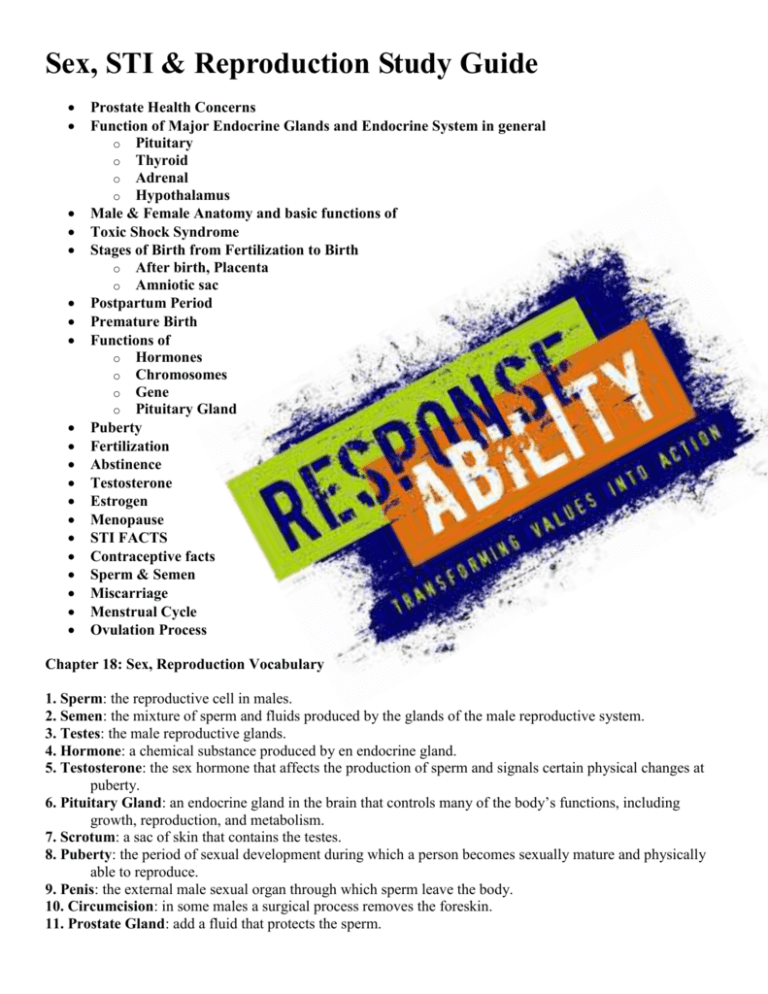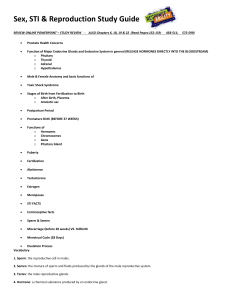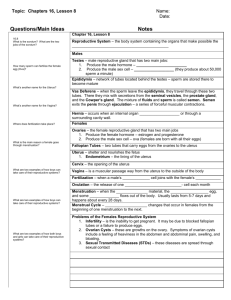Sex, STI & Reproduction Study Guide Prostate Health Concerns
advertisement

Sex, STI & Reproduction Study Guide Prostate Health Concerns Function of Major Endocrine Glands and Endocrine System in general o Pituitary o Thyroid o Adrenal o Hypothalamus Male & Female Anatomy and basic functions of Toxic Shock Syndrome Stages of Birth from Fertilization to Birth o After birth, Placenta o Amniotic sac Postpartum Period Premature Birth Functions of o Hormones o Chromosomes o Gene o Pituitary Gland Puberty Fertilization Abstinence Testosterone Estrogen Menopause STI FACTS Contraceptive facts Sperm & Semen Miscarriage Menstrual Cycle Ovulation Process Chapter 18: Sex, Reproduction Vocabulary 1. Sperm: the reproductive cell in males. 2. Semen: the mixture of sperm and fluids produced by the glands of the male reproductive system. 3. Testes: the male reproductive glands. 4. Hormone: a chemical substance produced by en endocrine gland. 5. Testosterone: the sex hormone that affects the production of sperm and signals certain physical changes at puberty. 6. Pituitary Gland: an endocrine gland in the brain that controls many of the body’s functions, including growth, reproduction, and metabolism. 7. Scrotum: a sac of skin that contains the testes. 8. Puberty: the period of sexual development during which a person becomes sexually mature and physically able to reproduce. 9. Penis: the external male sexual organ through which sperm leave the body. 10. Circumcision: in some males a surgical process removes the foreskin. 11. Prostate Gland: add a fluid that protects the sperm. 12. Bulbourethal Gland: adds a fluid that protects the sperm from acidic condition in the urethra. 13. Epididymis: when sperm grows and matures it is stored here. 14. Seminal Vesicle: adds a fluid that provides a source of energy for the active sperm. 15. Vas Deferens: sperm travels through here to get to the seminal vesicle. 1. Uterus: the hollow, muscular, pear-shaped organ in which a fertilized egg develops and grows. 2. Ovaries: the female reproductive glands. 3. Estrogen: the female sex hormone that signals certain physical changes at puberty and controls the maturation of eggs. 4. Vagina: the hollow, muscular passage leading from the uterus to the outside of the female body. 5. Pap Smear: a medical procedure in which a sample of cell is taken from the cervix and examined under a microscope. 6. Ovulation: the process during which one of the ovaries releases a ripened egg. 7. Menstrual Cycle: the process during which an ovary releases a mature egg that travels to the uterus; if the egg is not fertilized the uterus lining is shed and a new cycle begins. 8. Ova: the reproductive cells in females 9. Menopause: the times of life during which the ovaries slow down their hormone production and no longer release mature eggs. 10. Mammogram: an x-ray of the breast that may detect breast cancer. 11. Fallopian Tubes: the passageways that carry eggs away from the ovaries. 12. Progesterone: a hormone that signals changes to a woman’s reproductive system during the menstrual cycle and pregnancy. 13. Toxic Shock Syndrome: Medical condition associated with the use of tampons by bacterial infection. 14. Endometriosis: tissue from the lining of the uterus that grows outside the uterus. 15. Cervix: expands to allow the baby to pass through. Chapter 22: STI’s 1. Antibiotic: a drug that inhibits or kills bacteria. 2. AIDS: acquired immunodeficiency syndrome, an often-fatal disease of the immune system caused by HIV infection. 3. Chlamydia: a very common sexually transmitted infection caused by bacteria. 4. HIV: the human immunodeficiency virus, an incurable sexually transmitted infection that can lead to AIDS. 5. Human Papilloma Virus: a very common viral sexually transmitted infection. 6. Gonorrhea: a bacterial sexually transmitted infection that infests the urinary tract of males and females and the reproductive organs of females. 7. Infertility: the condition of being unable to reproduce. 8. Opportunistic infection: an infection that attacks a person with a weakened immune system. 9. Pelvic Inflammatory Disease: a serous infection of the female reproductive organs that can lead to infertility or an ectopic pregnancy. 10. Sexually Transmitted Infections (STI): an infection caused by any pathogen that spreads from one person to another during sexual contact. 11. Syphilis: a serious bacterial sexually transmitted infection that progresses through 3 distinct stages. 12. Trichomoniasis: a sexually transmitted infection caused by a protozoan that infects the urinary tract or vagina. 13. T Cells: a type of lymphocyte that helps the immune system to destroy pathogens. 14. Urethritis: Inflammation of the lining to the urethra. 15. Vaginitis: a vaginal infection or irritation. 16. Hepatitis: inflammation of the liver. 17. Symptomatic Stage: when an HIV-infected person starts to experience symptoms.








